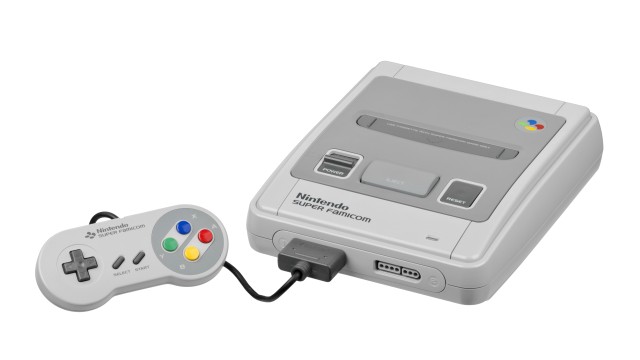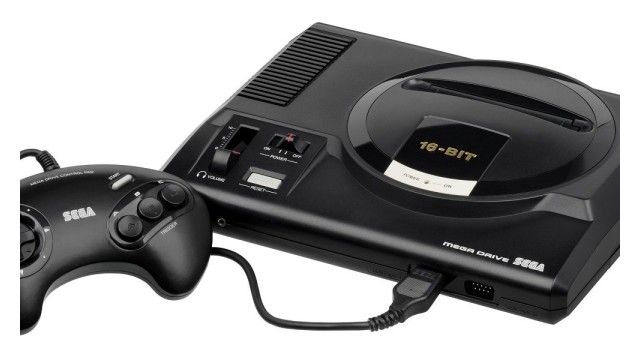
Super Nintendo
Launches: 1990
Discontinued: 2003
Life span: 13 years
Units sold: 49 100 000
Generation: 4th
Country releases of Super Nintendo
 Japan: Japan: | 21/Nov/1990 | 25000 | ¥ |
 USA: USA: | 23/Aug/1991 | 199 | $ |
 United Kingdom: United Kingdom: | 11/Apr/1992 | ||
 Iran: Iran: | 11/Apr/1992 | ||
 France: France: | 11/Apr/1992 | ||
 Spain: Spain: | 01/Jun/1992 | ||
 Europe: Europe: | 06/Jun/1992 | ||
 Australia: Australia: | 03/Jul/1992 | ||
 Germany: Germany: | 15/Aug/1992 | ||
 South Korea: South Korea: | Dec/1992 | ||
 Brazil: Brazil: | Aug/1993 |
 Super Nintendo technical specifications
Super Nintendo technical specifications
CPU: Ricoh 5A22 (16 bits)
Memory: 128 KB
 Super Nintendo video specifications
Super Nintendo video specifications
Super Nintendo graphics capabilities.
Video chip: SNES PPU
Video connection:
Super Nintendo video modes
| 256×224 | Progressive NTSC | |
| 512×448 | Interlaced NTSC | |
| 256×240 | Progressive PAL | |
| 512×480 | Interlaced PAL |
 Super Nintendo audio specifications
Super Nintendo audio specifications
Super Nintendo sound capabilities.
Audio chip: Nintendo S-SMP
Audio mode: Stereo
 Controllers of Super Nintendo
Controllers of Super Nintendo
 Super Nintendo games support
Super Nintendo games support
Support:
Super Nintendo games
Games library: 1757
Super Nintendo story
The Super Nintendo Entertainment System (SNES), known as the Super Famicom in Japan, holds a monumental place in the history of video gaming. Its creation, development, launch, and market reception illustrate not only the evolution of Nintendo as a company but also the broader shifts in the gaming industry during the early 1990s. The SNES was Nintendo’s response to the growing competition in the console market, particularly from Sega’s Genesis, and represented a major leap forward in terms of technology, gameplay, and cultural impact.
The creation of the SNES was driven by Nintendo’s need to maintain its dominance in the video game market, which it had established with the success of the Nintendo Entertainment System (NES) in the 1980s. By the late 1980s, however, the gaming landscape was changing rapidly. The NES had been a groundbreaking console, but it was beginning to show its age in the face of new technological advancements. The 16-bit era was dawning, promising better graphics, more complex gameplay, and richer sound. Sega had already entered this space with its Genesis console, which was gaining popularity, particularly in North America, and posed a serious challenge to Nintendo’s market leadership.
Nintendo’s president at the time, Hiroshi Yamauchi, recognized the need for a more powerful console that could meet the demands of this new era. The design and development of the SNES began with a focus on creating a system that would not only improve upon the NES but also offer superior capabilities compared to its competitors. Nintendo was determined to create a console that would push the boundaries of what was possible in video games, offering enhanced graphics, sound, and gameplay experiences that would capture the imagination of players worldwide.
The development of the SNES was a complex process that involved significant advancements in hardware and software design. The console was designed around a 16-bit architecture, which was a major step up from the 8-bit technology of the NES. The central processing unit (CPU) of the SNES was a custom-designed Ricoh 5A22, which was based on the 16-bit WDC 65C816 microprocessor. This CPU was capable of handling more complex calculations, which allowed for more detailed graphics and faster gameplay. The graphics processing was supported by the Picture Processing Unit (PPU), which was capable of producing a palette of 32,768 colors and supported multiple scrolling backgrounds, sprites, and a variety of graphical effects that had been impossible on the NES.
One of the most important features of the SNES was its sound capabilities. Nintendo worked with Sony to develop the S-SMP sound chip, which provided the SNES with advanced audio features, including support for stereo sound and multiple channels of digital audio. This collaboration was significant, as it marked the beginning of a relationship between Nintendo and Sony that would later influence the development of the PlayStation. The sound chip allowed for much richer and more immersive soundscapes in games, which became one of the defining characteristics of the SNES and contributed to the console’s reputation for high-quality audio.
In terms of design, the SNES was a marked departure from the NES. The console featured a sleek, modern look with a more rounded design compared to the boxy appearance of its predecessor. The SNES controller was also a significant evolution, introducing shoulder buttons for the first time, which added a new layer of complexity to gameplay and would become a standard feature in future console designs. The controller’s design, with its four face buttons and ergonomic shape, was highly influential and is still seen in modern gaming controllers.
The launch of the SNES was highly anticipated, following a period of intense speculation and excitement within the gaming community. Nintendo first launched the console in Japan on November 21, 1990, under the name Super Famicom. The Japanese launch was an immediate success, with the initial shipment of 300,000 units selling out within hours. The popularity of the console led to widespread shortages, and it quickly became one of the most sought-after items in the country. The enthusiasm for the Super Famicom set the stage for its international launch.
The North American release followed on August 23, 1991, where the console was rebranded as the Super Nintendo Entertainment System (SNES). The U.S. launch was accompanied by an aggressive marketing campaign that emphasized the console’s superior graphics and sound compared to its competitors. The slogan “Now You’re Playing with Super Power” captured the essence of Nintendo’s message: the SNES was the next evolution of gaming, offering an experience that was unmatched by any other console at the time. The North American launch was a success, though it was not without challenges. Sega’s Genesis was already well-established in the market, and the competition between the two consoles became one of the most famous rivalries in gaming history.
The market reception of the SNES was largely positive, though it varied by region. In Japan, the Super Famicom quickly dominated the market, continuing Nintendo’s legacy as the leading console manufacturer. In North America, the SNES faced stiffer competition from the Sega Genesis, which had captured a significant portion of the market with its head start and aggressive marketing. Sega’s strategy of targeting older gamers with its “Genesis Does What Nintendon’t” campaign highlighted the differences between the two consoles, with Sega positioning the Genesis as the cooler, more mature option.
Despite the competition, the SNES steadily gained ground, thanks in large part to its strong library of games. Nintendo’s first-party titles were some of the most anticipated and best-selling games on the platform. Super Mario World, which was bundled with the console at launch, became an instant classic and showcased the full potential of the SNES’s capabilities. The game’s vibrant graphics, expansive levels, and innovative gameplay mechanics made it a defining title for the console and a benchmark for platformers.
Other key titles that contributed to the SNES’s success included The Legend of Zelda: A Link to the Past, Super Metroid, Donkey Kong Country, and Super Mario Kart. Each of these games not only demonstrated the technical capabilities of the SNES but also set new standards for their respective genres. The Legend of Zelda: A Link to the Past was praised for its deep and engaging gameplay, as well as its intricate world design, while Super Metroid introduced a level of atmospheric storytelling and exploration that was unprecedented at the time.
The SNES was also home to a wealth of third-party titles, many of which became iconic games in their own right. Companies like Square (now Square Enix), Capcom, Konami, and Enix produced some of their best work on the SNES. Role-playing games (RPGs) such as Final Fantasy VI (known as Final Fantasy III in North America), Chrono Trigger, and Secret of Mana are often cited as some of the greatest RPGs of all time, with complex narratives, memorable characters, and innovative gameplay mechanics. These titles helped to cement the SNES’s reputation as a console that was not only powerful but also capable of delivering deep, immersive gaming experiences.
The SNES’s market reception in Europe was also favorable, although it faced similar competition from the Sega Genesis (known as the Mega Drive in Europe). The European market was more fragmented due to differences in release dates and regional preferences, but the SNES eventually became a popular console across the continent. Nintendo’s strong brand recognition and the high quality of its games helped the SNES to overcome early challenges and establish a solid foothold in the European market.
As the 16-bit era progressed, the SNES continued to receive strong support from both Nintendo and third-party developers. The console’s lifespan extended well into the mid-1990s, even as the industry began to transition to 32-bit systems like the Sony PlayStation and the Sega Saturn. The SNES’s large and diverse library of games, combined with its technical prowess, ensured that it remained relevant and beloved by gamers long after its launch. By the time production of the SNES ceased, the console had sold approximately 49 million units worldwide, making it one of the best-selling and most influential consoles of all time.
The Super Nintendo Entertainment System was a monumental success for Nintendo, both in terms of technological innovation and market impact. Its creation and development were driven by the need to compete in the increasingly competitive video game industry, leading to a console that pushed the boundaries of what was possible in gaming at the time. The SNES’s launch was met with excitement and enthusiasm, and despite stiff competition, it went on to become a beloved console with a library of games that are still celebrated today. The market reception of the SNES cemented Nintendo’s reputation as a leader in the gaming industry, and the console’s legacy continues to influence the design and development of video games and consoles to this day.
Previous Nintendo console: NES
Next Nintendo console: Nintendo 64

